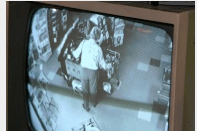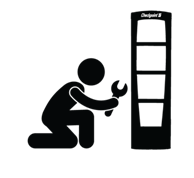I was at a recent conference with various LP departments across the retail industry not too long ago. I struck up a conversation with an LP manager from a high end clothing store. As conversations do, we ended up swapping stories about shoplifters and the latest technology out there to combat them. Being from the apparel business, I asked what type of clothing security they use on some of the most expensive items they carry. His response was killer!
My stores have a rather large apparel footprint; however we are not exclusive to that category. We also have a rather large hardgoods section, so my clothing security experience was limited to a few Checkpoint tag varieties. Personally, if I’m having a problem with a certain item that we’re really getting hit hard on, I go to the ink tags. I don’t know what it is about those tags, but the thieves just hate them! Wait… you’re not reading this to hear about my tags; you want to know what my apparel buddy is using, don’t you?
Imagine having a store where you carry a dress that retails for $3,000. Maybe you are that retailer, or perhaps are familiar with one. What can be done to really secure that dress? Sure, you can put Checkpoint tags front and center and it will most likely deter anyone from trying to steal it. Well what happens if someone, even after you secure the product, is able to steal it? Will your staff be alert enough to get a license plate number? Is your camera system good enough for the police to run the image through facial recognition? All three of those are a big, fat maybe… if you’re lucky. What if you could install a tiny GPS tracker in your most expensive items? That’s exactly what this retailer is experimenting with.
How awesome is that? Someone comes in, steals something from you, but you don’t fret. You just log into your computer and alert the local authorities to its exact location. Bad guy goes to jail, you get your product back, and everybody wins. I honestly think this is the future not only for clothing security, but retail LP in general. It’s a fascinating new technology and ideas that will no-doubt prove itself over time. Probably within 5-8 years, the technology will be small enough and cheap enough that it will be within financial reach of all retail outlets, no matter their size.
For now, that technology is a ways off, even if some high end folks are testing it out. For now, the gold standard and go to clothing security device for me will still be Checkpoint tags. For now, I’ll just dream about the day when Checkpoint tags will come standard with GPS tracking. Just imagining the look on the shoplifter that thought they got away is priceless!
Get more information on Clothing Security, contact us or call 1.770.426.0547 today.



 forbid a competitive system). It is installed and your shoplifting losses go down. They will! The simple act of installing a system will make a percentage of your shoplifters go elsewhere.
forbid a competitive system). It is installed and your shoplifting losses go down. They will! The simple act of installing a system will make a percentage of your shoplifters go elsewhere.


 ch these live webinars as reasonably often as you need. Staff turnover, promotions, follow up training, one employee or fifty…. Just schedule the session. Oh, by the way. I will also provide you with 15 draft LP Policies and Procedures that you can customize to your operation. Shoplifting, employee theft, robbery, key control…..
ch these live webinars as reasonably often as you need. Staff turnover, promotions, follow up training, one employee or fifty…. Just schedule the session. Oh, by the way. I will also provide you with 15 draft LP Policies and Procedures that you can customize to your operation. Shoplifting, employee theft, robbery, key control…..
 If you work in retail then you know theft is a big problem. The theft of supplies, merchandise, time and money are just a few of the things managers have to deal with daily. They have to address it on many fronts (i.e., impulse and professional shoplifters, employees and their friends and families, vendors).
If you work in retail then you know theft is a big problem. The theft of supplies, merchandise, time and money are just a few of the things managers have to deal with daily. They have to address it on many fronts (i.e., impulse and professional shoplifters, employees and their friends and families, vendors). Retail alarms are necessary to ensure a store is protected against break-ins and even theft from within. I know from personal experience that they work. As a Loss Prevention Manager I once had to respond to a burglary alarm when two young men threw a cement block through the front doors of my store in the middle of the night. I also responded to a number of false alarms due to system errors and failures. As a Manager On Duty I know that it can be stressful wondering if you locked all the doors and set the alarm at the end of the night. With those situations in mind, I would like to provide some practical tips to help avoid excessive false alarms and worry about building security.
Retail alarms are necessary to ensure a store is protected against break-ins and even theft from within. I know from personal experience that they work. As a Loss Prevention Manager I once had to respond to a burglary alarm when two young men threw a cement block through the front doors of my store in the middle of the night. I also responded to a number of false alarms due to system errors and failures. As a Manager On Duty I know that it can be stressful wondering if you locked all the doors and set the alarm at the end of the night. With those situations in mind, I would like to provide some practical tips to help avoid excessive false alarms and worry about building security.